roof rack VOLKSWAGEN TRANSPORTER 1990 T4 / 4.G Owners Manual
[x] Cancel search | Manufacturer: VOLKSWAGEN, Model Year: 1990, Model line: TRANSPORTER, Model: VOLKSWAGEN TRANSPORTER 1990 T4 / 4.GPages: 165, PDF Size: 24.87 MB
Page 4 of 165
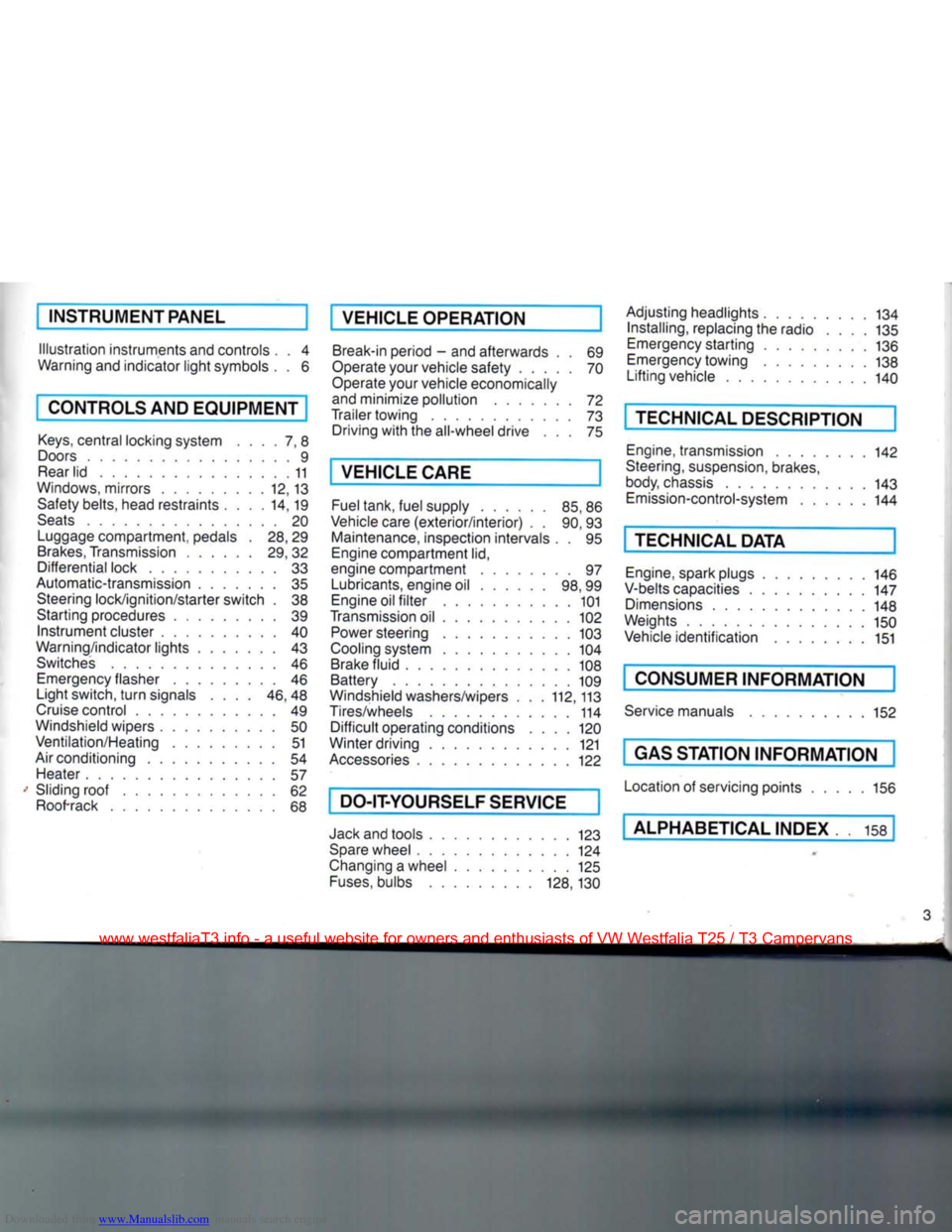
Downloaded from www.Manualslib.com manuals search engine
1
INSTRUMENT PANEL
Illustration instruments and controls
Warning and indicator light symbols
CONTROLS AND EQUIPMENT
Keys,
central locking system .... 7, 8
Doors 9
Rear lid 11
Windows, mirrors 12, 13 Safety belts, head restraints . . . .14,19
Seats 20 Luggage compartment, pedals . 28,29
Brakes, Transmission 29, 32 Differential lock 33
Automatic-transmission 35 Steering lock/ignition/starter switch . 38
Starting procedures 39 Instrument cluster 40
Warning/indicator lights 43 Switches 46 Emergency flasher 46
Light switch, turn signals .... 46,48
Cruise control 49
Windshield wipers 50 Ventilation/Heating 51
Air conditioning 54
Heater 57
Sliding roof 62
Roof-rack 68 VEHICLE OPERATION
Break-in period - and afterwards . . 69
Operate your vehicle safety 70
Operate your vehicle economically
and minimize pollution 72
Trailer towing 73 Driving with the all-wheel drive ... 75
VEHICLE CARE
Fuel tank, fuel supply 85,86
Vehicle care (exterior/interior) . . 90, 93 Maintenance, inspection intervals . . 95 Engine compartment lid,
engine compartment 97 Lubricants, engine oil 98,99
Engine oil filter 101
Transmission oil 102
Power steering 103
Cooling system 104 Brake fluid 108
Battery 109
Windshield washers/wipers . . . 112,113
Tires/wheels 114 Difficult operating conditions .... 120
Winter driving 121
Accessories 122
DO-IT-YOURSELF SERVICE
Jack and tools 123 Spare wheel 124
Changing a wheel 125 Fuses, bulbs 128, 130 Adjusting headlights
134
Installing,
replacing the radio . . . . 135
Emergency starting 136
Emergency towing 138
Lifting vehicle . . 140
TECHNICAL DESCRIPTION
Engine, transmission 142
Steering,
suspension, brakes,
body, chassis 143 Emission-control-system 144
TECHNICAL DATA
Engine, spark plugs .
V-belts capacities . . Dimensions
Weights
Vehicle identification 146
147
148
150 151
CONSUMER INFORMATION
Service manuals 152
GAS STATION INFORMATION
Location of servicing points 156
ALPHABETICAL INDEX 158
www.westfaliaT3.info - a useful website for owners and enthusiasts of VW Westfalia T25 / T3 Campervans
Page 69 of 165
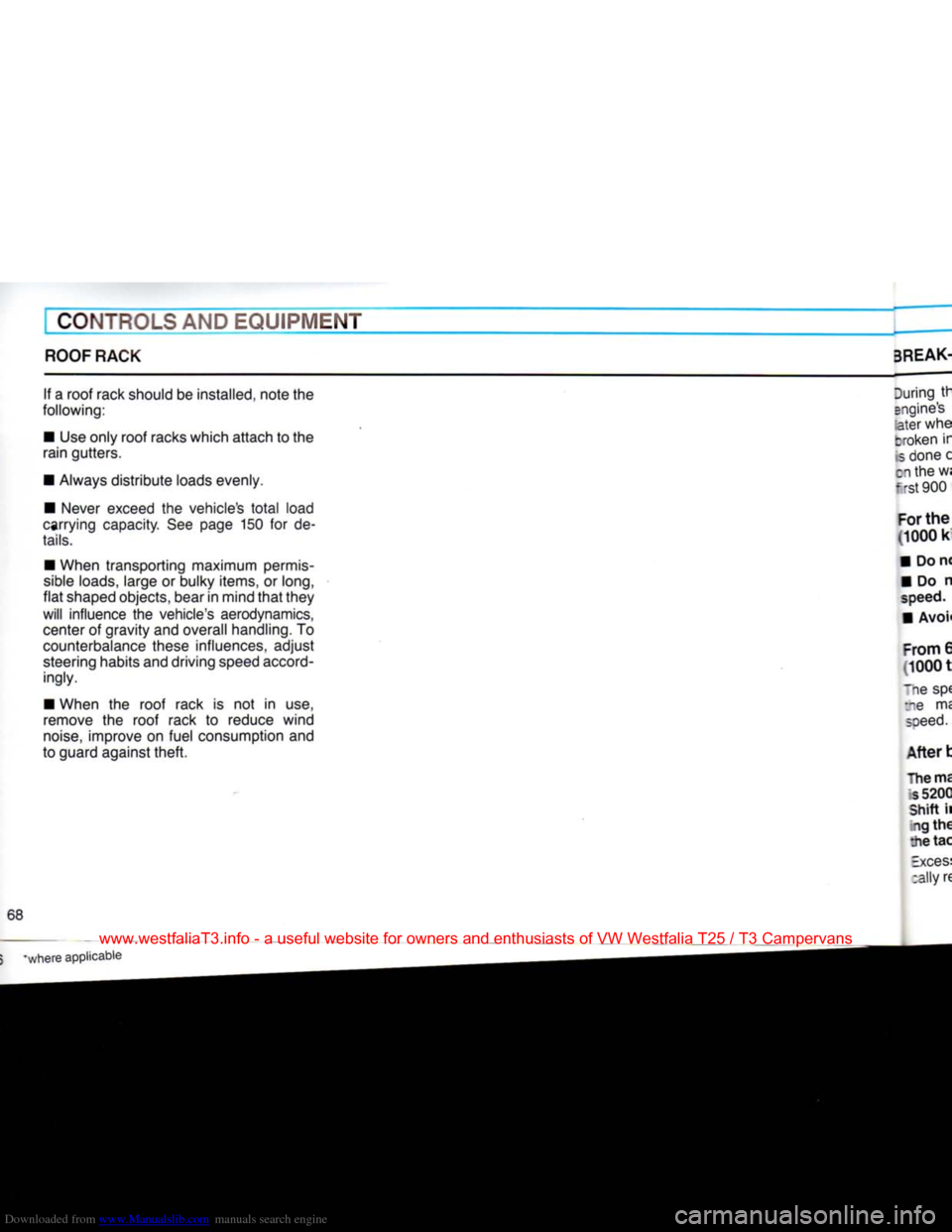
Downloaded from www.Manualslib.com manuals search engine
CONTROLS
AND
EQUIPMENT
ROOF RACK 3REAK-
If a roof rack should be installed, note the
following:
• Use only roof racks which attach to the
rain gutters.
• Always distribute loads evenly.
• Never exceed the vehicle's
total
load
carrying capacity. See page 150 for de
tails.
• When transporting maximum permis
sible
loads, large or bulky items, or long,
flat
shaped objects, bear in mind
that
they
will
influence the vehicle's aerodynamics,
center of gravity and overall handling. To
counterbalance these influences, adjust steering habits and driving speed accord
ingly.
• When the roof rack is not in use,
remove the roof rack to reduce wind
noise,
improve on fuel consumption and
to guard against
theft.
68
www.westfaliaT3.info - a useful website for owners and enthusiasts of VW Westfalia T25 / T3 Campervans
Page 73 of 165
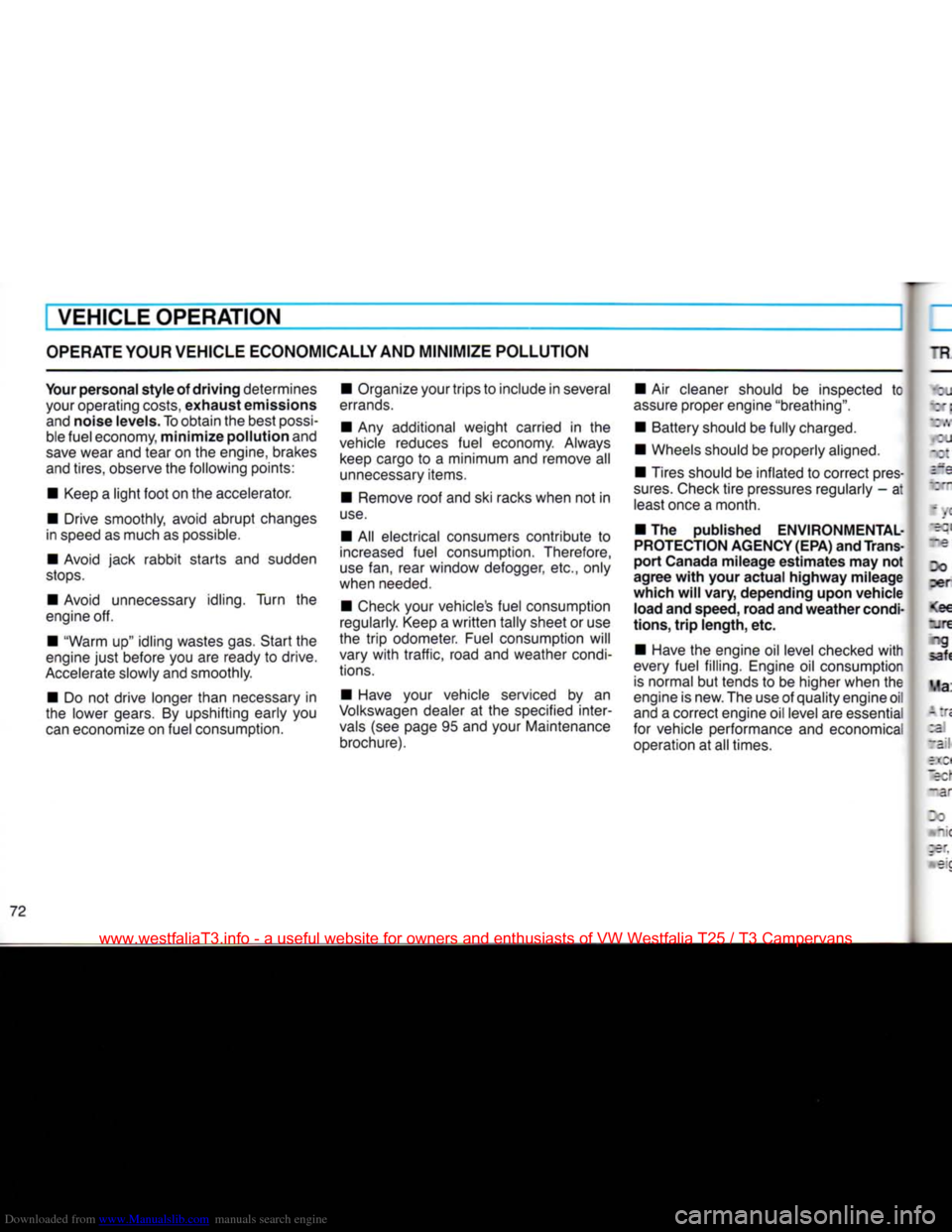
Downloaded from www.Manualslib.com manuals search engine
VEHICLE OPERATION
OPERATE
YOUR VEHICLE ECONOMICALLY AND
MINIMIZE
POLLUTION
Your
personal
style
of
driving
determines your operating costs,
exhaust
emissions and noise levels. To obtain the best
possi
ble fuel economy,
minimize
pollution
and
save
wear and tear on the engine, brakes
and tires, observe the following points:
• Keep a
light
foot
on the accelerator.
• Drive smoothly, avoid abrupt changes
in speed as much as possible.
• Avoid jack rabbit starts and sudden
stops.
• Avoid unnecessary idling. Turn the
engine off.
• "Warm up" idling wastes gas. Start the
engine
just
before you are ready to drive.
Accelerate
slowly and smoothly.
• Do not drive longer than necessary in
the lower gears. By upshifting early you
can
economize on fuel consumption. • Organize your trips to include in several
errands.
• Any additional weight carried in the
vehicle reduces fuel economy. Always keep cargo to a minimum and remove all
unnecessary
items.
• Remove roof and ski racks when not in
use.
• All electrical consumers contribute to
increased
fuel consumption. Therefore,
use
fan, rear window defogger, etc., only
when needed.
• Check your vehicle's fuel consumption
regularly. Keep a
written
tally sheet or use
the
trip
odometer. Fuel consumption will
vary
with
traffic, road and weather condi
tions.
• Have your vehicle serviced by an
Volkswagen
dealer at the specified inter
vals
(see page 95 and your Maintenance brochure). • Air cleaner should be inspected to
assure
proper engine "breathing".
• Battery should be fully charged.
• Wheels should be properly aligned.
• Tires should be inflated to correct pres
sures.
Check
tire
pressures regularly - at least once a month.
• The published ENVIRONMENTAL-
PROTECTION AGENCY (EPA) and Trans
port
Canada
mileage
estimates
may not
agree
with
your
actual
highway
mileage
which
will
vary,
depending
upon
vehicle
load
and speed,
road
and
weather
condi
tions,
trip
length,
etc.
• Have the engine oil level checked
with
every fuel filling. Engine oil consumption
is
normal but tends to be higher when the
engine is new. The use of quality engine oil
and a correct engine oil level are essential
for vehicle performance and economical operation at all times.
72
www.westfaliaT3.info - a useful website for owners and enthusiasts of VW Westfalia T25 / T3 Campervans
Page 97 of 165
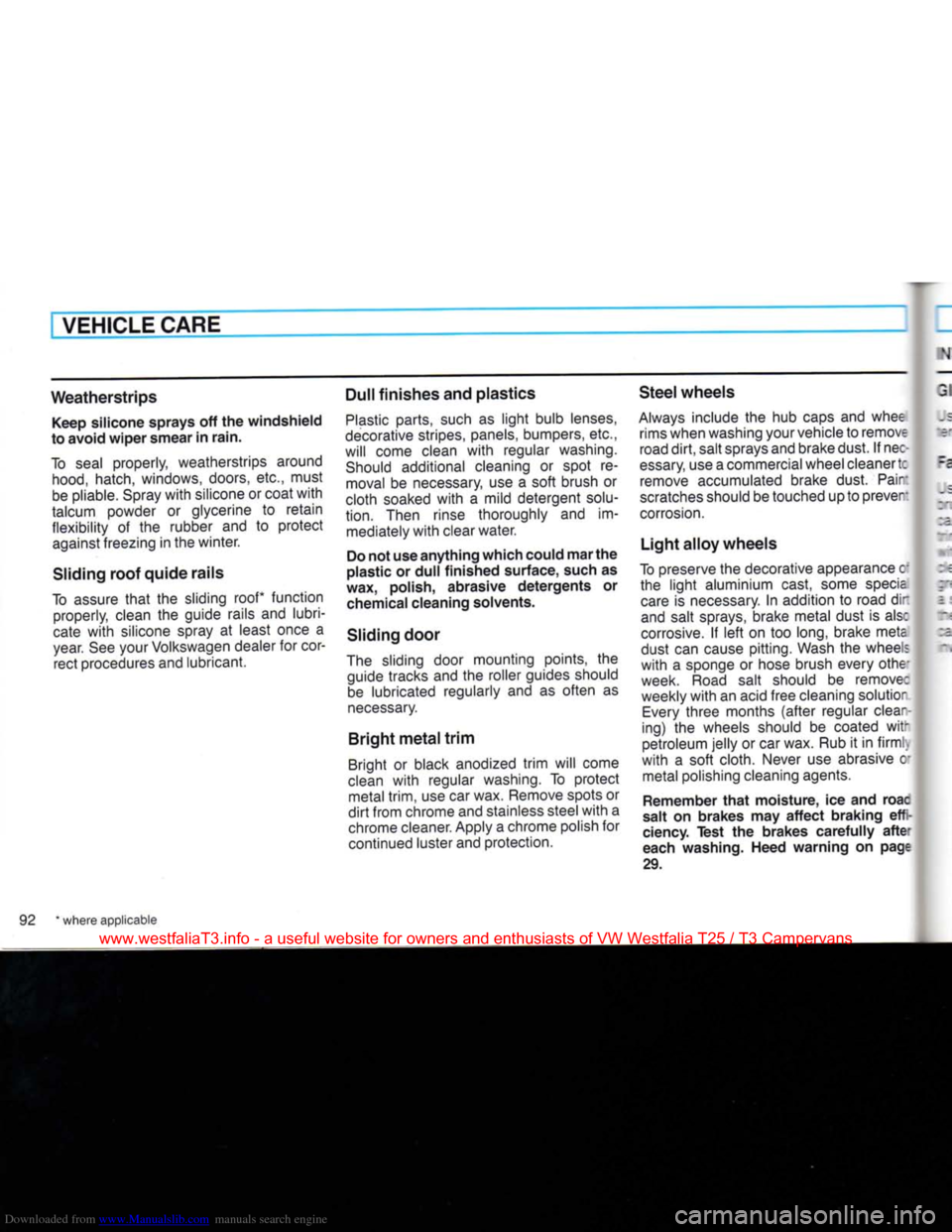
Downloaded from www.Manualslib.com manuals search engine
VEHICLE
CARE
Weatherstrips
Keep silicone sprays
off the
windshield
to avoid wiper smear
in
rain.
To seal properly, weatherstrips around
hood,
hatch, windows, doors,
etc.,
must
be pliable. Spray with silicone
or
coat with
talcum powder
or
glycerine
to
retain
flexibility
of the
rubber
and to
protect against freezing
in the
winter.
Sliding roof quide rails
To assure that
the
sliding roof* function properly, clean
the
guide rails
and
lubri
cate with silicone spray
at
least once
a
year.
See
your Volkswagen dealer
for
cor rect procedures
and
lubricant.
Dull finishes and plastics
Plastic parts, such
as
light bulb lenses,
decorative stripes, panels, bumpers,
etc.,
will come clean with regular washing. Should additional cleaning
or
spot
re
moval
be
necessary,
use a
soft brush
or
cloth soaked with
a
mild detergent
solu
tion.
Then rinse thoroughly
and im
mediately with clear water.
Do not use anything which could mar the
plastic
or
dull finished surface, such
as
wax, polish, abrasive detergents
or
chemical cleaning solvents.
Sliding door
The sliding door mounting points,
the
guide tracks
and the
roller guides should be lubricated regularly
and as
often
as
necessary.
Bright metal trim
Bright
or
black anodized trim will come
clean with regular washing.
To
protect metal
trim,
use car
wax. Remove spots
or
dirt from chrome
and
stainless steel with
a
chrome cleaner. Apply
a
chrome polish
for
continued luster and protection.
Steel wheels
Always include
the hub
caps
and
whee rims when washing your vehicle
to
remove
road dirt, salt sprays and brake dust.
If
nec
essary,
use a
commercial wheel cleaner
t:
remove accumulated brake dust. Pain:
scratches should
be
touched
up to
prever
corrosion.
Light alloy wheels
To preserve
the
decorative appearance
c-
the light aluminium cast, some specie
care
is
necessary.
In
addition
to
road
dr
and salt sprays, brake metal dust
is
alsc
corrosive.
If
left
on too
long,
brake meta
dust
can
cause pitting. Wash
the
wheels
with
a
sponge
or
hose brush every othe-
week. Road salt should
be
remove:
weekly with
an
acid free cleaning solutior Every three months (after regular clear
ing)
the
wheels should
be
coated
wit-
petroleum jelly
or car
wax.
Rub it in
firml.
with
a
soft cloth. Never
use
abrasive
c
metal polishing cleaning agents.
Remember that moisture,
ice and
roac
salt
on
brakes
may
affect braking
eff
ciency. Test
the
brakes carefully afte'
each washing. Heed warning
on
page
29.
92
*
where applicable
www.westfaliaT3.info - a useful website for owners and enthusiasts of VW Westfalia T25 / T3 Campervans
Page 155 of 165
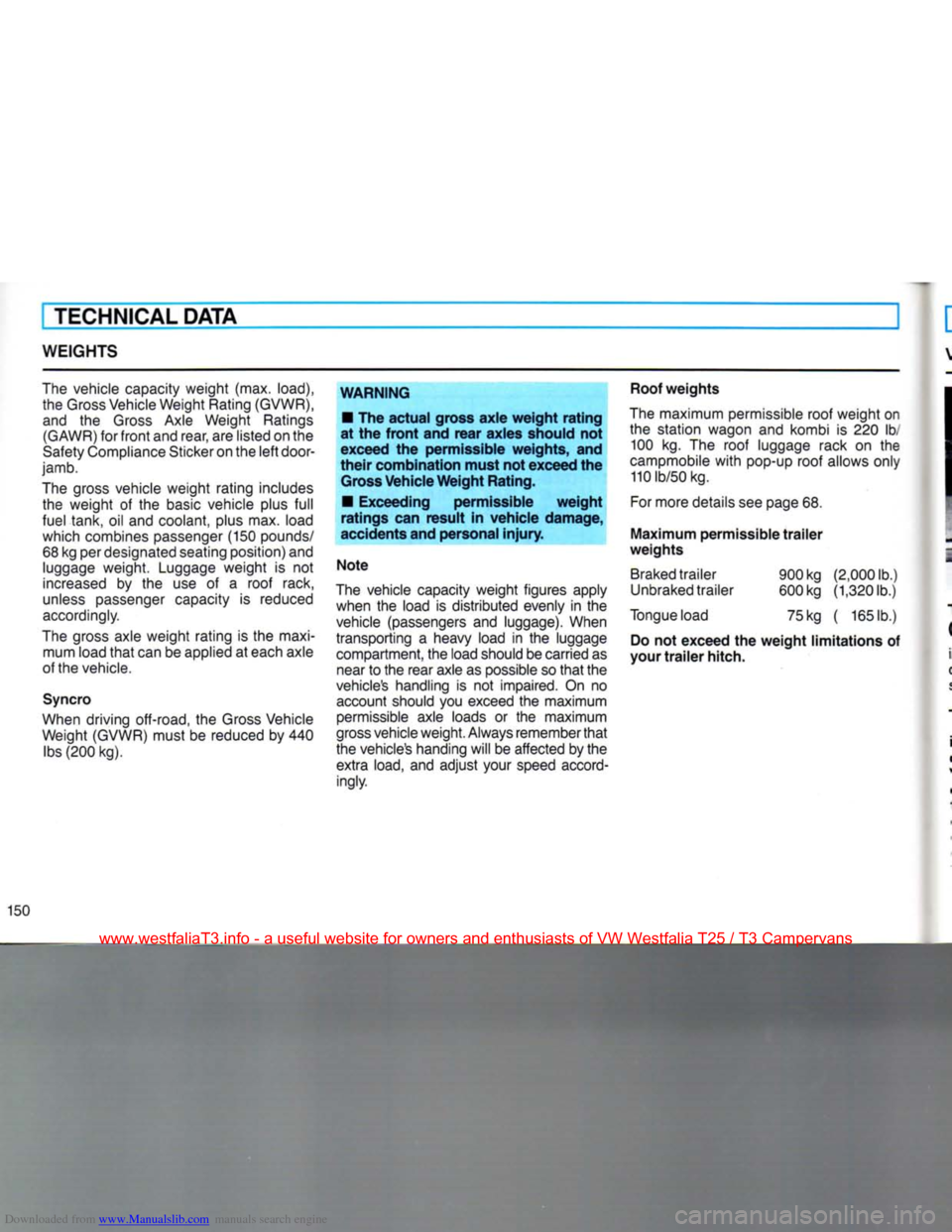
Downloaded from www.Manualslib.com manuals search engine
TECHNICAL DATA
WEIGHTS
The vehicle capacity weight (max. load), the
Gross
Vehicle Weight Rating
(GVWR),
and
the
Gross
Axle Weight Ratings
(GAWR)
for
front
and rear, are listed on the
Safety
Compliance Sticker on the
left
door-
jamb.
The gross vehicle weight rating includes the weight
of the
basic
vehicle plus
full
fuel tank,
oil and
coolant, plus max. load which combines passenger (150 pounds/
68 kg per designated seating position) and luggage weight. Luggage weight
is not
increased
by the use of a
roof rack,
unless
passenger capacity
is
reduced
accordingly.
The gross axle weight rating
is the
maxi mum load
that
can be applied
at
each axle
of the vehicle.
Syncro
When driving off-road,
the
Gross
Vehicle
Weight
(GVWR)
must
be
reduced
by 440
lbs (200 kg).
WARNING
•
The actual
gross
axle
weight
rating
at the
front
and rear axles should not
exceed the permissible weights, and
their
combination must not exceed the
Gross
Vehicle Weight Rating.
•
Exceeding permissible
weight
ratings can result in vehicle damage,
accidents and personal injury.
Note
The vehicle capacity weight figures apply when
the
load
is
distributed evenly
in the
vehicle (passengers
and
luggage). When
transporting
a
heavy load
in the
luggage
compartment,
the
load should be carried
as
near
to
the rear axle as possible so
that
the
vehicle's
handling
is not
impaired.
On no
account should
you
exceed
the
maximum
permissible axle loads
or the
maximum
gross
vehicle weight. Always remember
that
the vehicle's handing
will
be
affected by
the
extra
load,
and
adjust your speed accordingly.
Roof
weights
The maximum permissible roof weight
on
the station wagon
and
kombi
is 220 lb,
100
kg. The
roof luggage rack
on the
campmobile
with
pop-up roof allows only 110 lb/50 kg.
For
more details see page 68.
Maximum permissible
trailer
weights
Braked
trailer 900 kg (2,000 lb.) Unbraked trailer 600 kg (1,3201b.)
Tongue load 75 kg
(
1651b.)
Do not exceed the
weight
limitations of
your
trailer
hitch.
150
www.westfaliaT3.info - a useful website for owners and enthusiasts of VW Westfalia T25 / T3 Campervans
Page 163 of 165
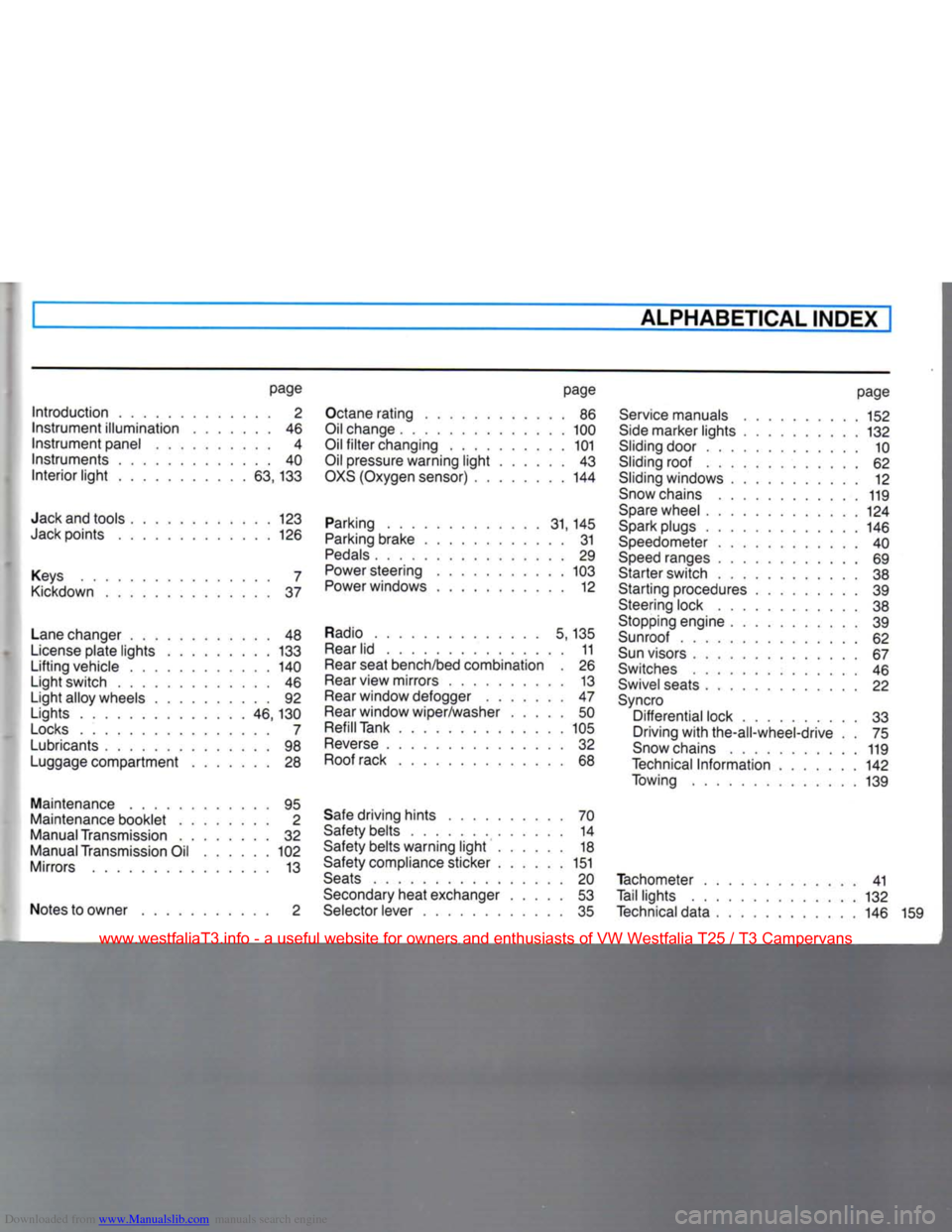
Downloaded from www.Manualslib.com manuals search engine
ALPHABETICAL INDEX
page
Introduction 2
Instrument illumination 46
Instrument panel 4 Instruments 40
Interior light 63,133
Jack and tools 123 Jack points 126
Keys 7
Kickdown 37
Lane changer 48
License plate lights 133 Lifting vehicle 140
Light switch 46 Light alloy wheels 92
Lights 46,130
Locks 7
Lubricants 98
Luggage compartment 28
Maintenance 95
Maintenance booklet 2
Manual Transmission 32 Manual Transmission Oil 102
Mirrors 13
Notes to owner 2 page
Octane rating 86
Oil change 100
Oil filter changing 101 Oil pressure warning light 43
OXS (Oxygen sensor) 144
Parking 31,145
Parking brake 31 Pedals 29
Power steering 103
Power windows 12
Radio 5, 135
Rear lid 11 Rear seat bench/bed combination 26
Rear view mirrors 13
Rear window defogger 47
Rear window wiper/washer 50
Refill Tank 105
Reverse 32
Roof rack 68
Safe driving hints 70
Safety belts 14
Safety belts warning light 18
Safety compliance sticker 151
Seats 20 Secondary heat exchanger 53
Selector lever 35 page
Service manuals 152 Side marker lights 132
Sliding door 10 Sliding roof 62
Sliding windows 12
Snow chains 119 Spare wheel 124
Spark plugs 146
Speedometer 40
Speed ranges 69
Starter switch 38 Starting procedures 39
Steering lock 38
Stopping engine 39
Sunroof 62 Sun visors 67
Switches 46
Swivel seats 22 Syncro Differential lock 33
Driving with the-all-wheel-drive . . 75
Snow chains 119
Technical Information 142 Towing 139
Tachometer 41
Tail lights 132
Technical data 146
www.westfaliaT3.info - a useful website for owners and enthusiasts of VW Westfalia T25 / T3 Campervans